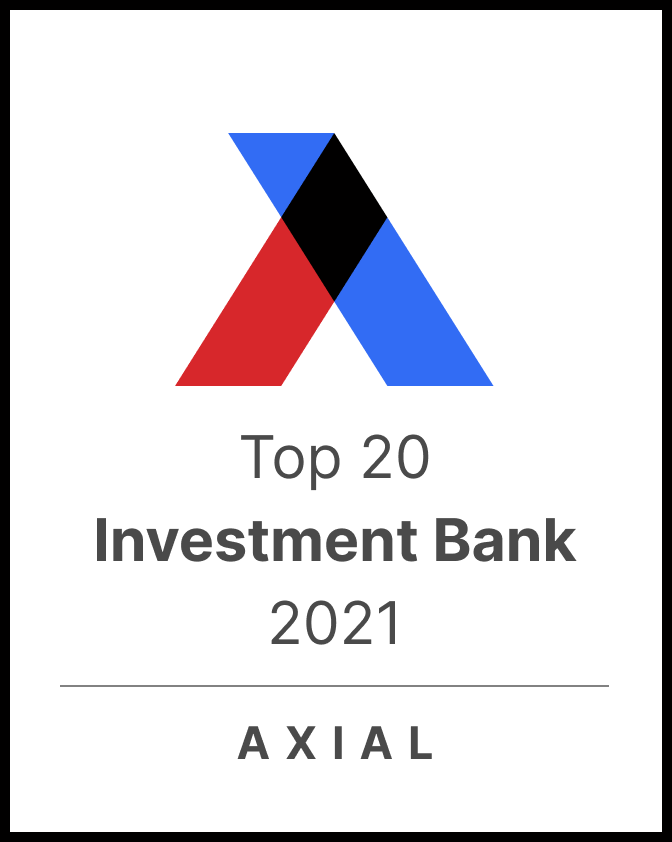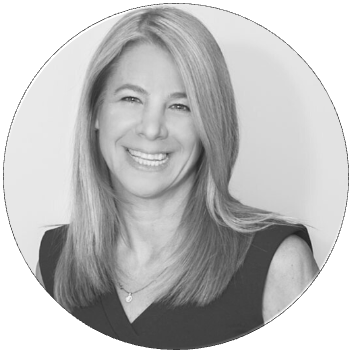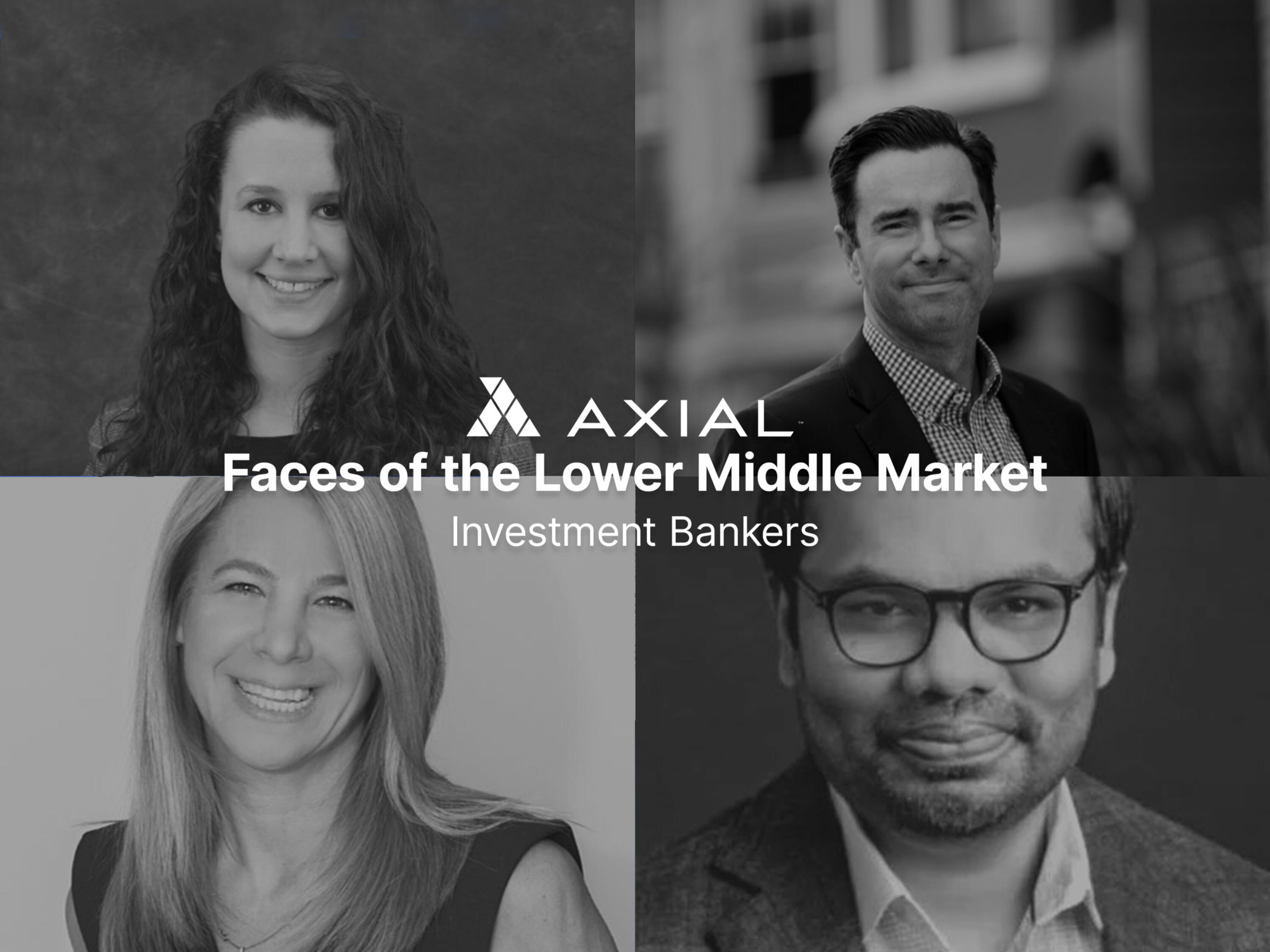
The Winning M&A Advisor [Vol. 1, Issue 5]
Welcome to the latest issue of The Winning M&A Advisor, the Axial publication that anonymously unpacks data, fees, and terms…
It’s been a busy year for members on the Axial platform, with hundreds of investment banks and M&A advisors bringing more than 6,000 deals to market so far in 2021. This activity lines up with the trends we’ve seen across the broader M&A market, which has set new records in the third quarter reaching $1.5T in transaction value, according to Refinitiv. At this pace, 2021 is shaping up to be the strongest year for M&A across the deal spectrum since records began.
When you analyze aggregate deal activity on Axial over the last quarter, specific firms begin to emerge for their consistent success and excellence in representing SMBs during the sales process.
The teams at Focus Investment Banking, Britehorn Partners, Sunfield Advisors, Peak Technology Partners, and the others who earned their place in the recent Axial Q3 Investment Banking League Tables, are among the most selective, efficient and best-positioned banking teams in the lower-middle market today, based on Axial key performance metrics.
We recently sat down with bankers at several of our top ranked organizations to learn more about the individuals behind the deals. Here’s what they had to say:


Over the last 30 years, FOCUS Investment Banking has carved out a reputation for specialty M&A advisory services with verticals ranging from advanced manufacturing and healthcare to defense, telecom and more. It works with middle-market clients between $10–$300 million who do most of their business online, usually at least 90%. Leah White, the bank’s e-commerce principal, has been with the firm since 2019, helping clients craft M&A strategies, keeping FOCUS abreast of developments in her rapidly changing market, and maximizing the value of every transaction.
You have an interesting specialty, so let’s start at the beginning and talk about what got you into this line of work.
Leah White: Going back to my undergraduate days, I was really anxious to get into the workforce, so I fast-tracked my finance degree in just a little over two years. I jumped into a variety of financial planning and analysis roles and did some financial strategy for large companies. I worked for a large, privately held logistics company that was ultimately bought by FedEx. I worked for Mylan, Royal Bank of Scotland, and Citizens Bank.
But then I decided that I really wanted to focus on investing from an institutional perspective, so I joined a large institutional investor in Pittsburgh that had a portfolio of just under $2 billion. I was there for about five years, managing research around the portfolio, which was my first contact with private equity and entrepreneurs, and moved over to FOCUS in 2019.
What was it that caught your attention?
LW: I really enjoy working with private equity groups and, in particular, learning about how they choose which entrepreneurs to work with and how they study industries, and then getting to meet some of those entrepreneurs. I’ve always been intrigued about that part of the business; it’s really exciting to me. Being an entrepreneur is something that I really admire, so getting to have those conversations gives me a lot of energy.
What are you seeing in the e-commerce market in 2021?
LW: First of all, 2021 has been a great year. The e-commerce market is exploding right now, and there’s just so much opportunity in so many different parts of e-commerce. In the last few years, $10 billion has been raised to purchase Amazon FBA groups—Fulfillment by Amazon—by aggregators, so just in that space alone we’ve been seeing a ton of activity.
But also, on the other side of the market are those companies selling primarily on their own websites, or even some retailers that have a brick-and-mortar component. All aspects of the industry are growing rapidly. On the whole, 2021 has been a great year to launch our e-commerce vertical.
Obviously, there is the COVID-19 factor in e-commerce over the last year, but why else is it so hot right now?
LW: COVID certainly, but there was also a trend toward more e-commerce purchases pre-COVID. The dynamics of the pandemic just amplified that trend. We’re seeing 40 percent of clothing purchases being made online, with Amazon becoming the largest marketplace in the world for that. I just read an article that said $1 in every $4 spent this holiday season will be spent online—despite some of the supply chain issues that worry people.
E-commerce is here to stay. COVID amplified it a little bit, for sure, but we’re seeing purchasing behaviors increasingly trending toward digital, especially among the younger age groups. And that includes things that many people maybe would never have considered purchasing online in the past. It’s deepening and broadening at the same time.
One of the drivers in terms of consumer behavior is that ,as this market continues to grow, the convenience factor is really going to come into play. Once I start ordering all of my diapers, baby products and everything else online, why would I then go back to the store for those items?
We are still seeing confusion among some people who are still primarily brick-and-mortar shoppers, but omni-channel appetite is starting to take over. Even the big boys like Target are doing a huge percentage of sales online, even more than in the past. As more and more people get used to those conveniences, they’re more apt to continue that behavior, and that’s only a good thing for e-commerce.
I always think of private equity going after bigger fish, and e-commerce sometimes seems like more of an owner-operator market. The idea that those are being rolled up is interesting to an outsider.
LW: There’s just so much money in private equity right now that needs to be put to work, and the returns in e-commerce are a lot higher than in other industries. As a strategic investor, there are a lot of things that you can do once you’ve built that e-commerce sales engine. Maybe you have effective SEO tactics, thoughtfully researched ways to spend your ad dollars, optimized your supply chain… You can scale that and apply it to a broad portfolio of e-commerce investments. We’re seeing those types of synergies a lot.
Any advice for founders looking at a potential deal?
LW: I would say to get your financial house in order. Make sure that you’re confident in your financials because that will play a big role in your market process. And then, once you’re under contract in the due diligence process, it’s important to have good data available.
Then it’s about having a good advisor who can help you communicate your value proposition and the things that are unique about your business. When you play in an industry day in and day out and that’s all you do, that experience is a huge advantage for your clients. When you’re in the market, just knowing who’s acquisitive in that space and who might be interested in a deal based on your prior conversations with them is a powerful differentiator that only the right advisor can bring.



These days there is no shortage of tech-focused investment bankers, but that wasn’t exactly the case in the late ʼ90s, when PEAK’s founders got their start. And that bootstrapped beginning not only helped the firm survive its early days but also better relate to their clients and understand the nuances of what sets technology M&A apart from other verticals.
What got you into the technology side of investment banking?
David Stevenson: I’ve been doing this since 2000, specifically focused on what I’m focused on now for about 13 of those 20+ years. The pivot really happened after business school, but, to me, technology was this special place compared to what a lot of my other colleagues going into investment banking were doing. It’s very typical in this business to cover a certain industry or a certain product. That’s not that interesting to me. You look at any of the verticals like manufacturing and oil and gas—all of the disruption, all of the change, all of that is interesting about them revolves around technology. It’s where all the disruption happens.
My thoughts? Why not just focus on that part, period? You can be vertically agnostic since, as they say, technology is horizontal, and that is where my passion really lies. I was a history major as an undergrad, and you can look at history through three basic lenses: economics, power, or technology. I’ve always thought that the economic and technology lenses were by far the most fascinating.
On the technology side, you’re doing IPOs and secondaries, and you’re acquiring a lot of businesses. In most industries, when you’re talking about M&A, it’s all about synergies. And most of the time, those synergies are mainly on what we call the cost side, which is another way of saying you’re either going to sell assets or fire people. That’s where your cost savings come from; that’s where the synergies are.
Technology is this special place where, because there’s so much disruption happening, when you talk about merging two companies the synergies are on the revenue side.
What does that look like in practice?
DS: I’ll give you an example. A lot of our clients have great technologies or great products, but they really don’t have the ability to sell or market them very well. If you plug them into, say, a Microsoft or another major acquirer that knows how to sell all day long, you can accelerate their development in that area and then sell what they’ve built.
So, after a tech merger happens, it’s actually more common for the company that just got acquired to ramp up hiring versus firing. I really like that aspect of it, too.
How does the lower middle market suit that mindset?
DS: I started at big banks and then moved on to the more mid-market-focused investment banks before starting my own, and I would say that there’s an inverse correlation between the size of the firm and how happy I was at those firms. Also, the smaller the firm the more likely it is I’ll be working with a founder.
It’s like that poem: “We are the music makers, And we are the dreamers of dreams.” I’m totally botching that quote [RH1] by the way, but it’s about the power of being the movers and shakers. And I really like that energy.
Let me contrast that with what the process was like at the larger firms. You’re calling on and working with people just like yourself. They all went to the same schools. You look the same. You are stewards of a larger business that you didn’t create. You just work there. That is a very different dynamic from somebody that has come up with an original idea and built it from the ground up. That is so much more interesting than just dealing with the stewards of these larger businesses.
That’s fascinating. But 20 years ago, technology was the new kid on the block. How has that changed over time?
DS: I mean, Moore’s law—the observation that the number of transistors in an integrated circuit doubles about every two years—has already been around for nearly 70 years, and we’re not done yet. What’s even wilder is when you think about how far it will go. A lot of very smart people have written a lot about what they call super intelligence. When you’re talking about something like AI in general intelligence, you think about the average IQ of human beings is 100. Imagine having a computer that’s 200 and 300 IQ. Now imagine if that IQ was 300,000.
And that’s not too far away. It will likely happen in our lifetime.
How do you decide who you work with, and how do those clients choose PEAK?
DS: The parameters around what sort of clients we’re looking for are pretty simple. We want to take on clients that are revenue producing. If they’re not profitable, they need to be growing very quickly. And if they’re not growing very quickly, we want them to have substantial profit margins. As far as the business model is concerned, yes, it should be within technology, and we tend to do more software and services than hardware because it’s a bit more commoditized, but there are exceptions. Very generally, we help companies, specifically technology companies, do one of two things: they’re either raising capital north of $20 million, or they’re selling themselves entirely.
But why do those clients choose PEAK? I’d say they pick us because we are very experienced within the technology space. We know the ecosystem very well, we have a solid track record of success, and we promise and deliver senior-level attention.
Lastly, and this is very important to some, we eliminate the conflicts of interest. And what do I mean by that? Rewind the clock to when I was with a previous bank. No names, but I’ll never forget literally sitting at a table on the sell side, and on the other side of the table was the buy-side. The buyers were with a very large private equity fund and our job, very simply, as the outside bankers was to optimize the outcome and maximize the valuation on the deal. It was a long day, so we took a break at some point and all of us bankers huddled in the conference room. And I’ll never forget what my managing director said at that point: “I feel like we can’t push on the private equity buyer anymore because they have another portfolio company that’s about to go on sale, and I want to represent them.” I was a new investment banker at the time, and I just stood there thinking: is this the way the world works? Really?
But it’s a tried-and-true business development tactic. How do most bankers find new clients? Most of them spend all day calling on private equity funds because you make one phone call and you can get access to sometimes hundreds of different companies that may be for sale. It’s a great way to build a network. But therein lies the problem. When you do that, who is the real client? So what we said when we first started—and this is at the core of the ethos of PEAK—we eliminate those conflicts of interests by not taking sides like that and instead focus on our clients alone, not third-party relationships.


Denver, CO
Denver isn’t a destination that many people think of when considering middle-market investment banks, but that didn’t stop industry veteran Bobbi Babitz and her partners when they launched the firm in the Mile High City in 2013. Now conducting transactions across the United States and Canada, Britehorn’s geographic location is one of its differentiators, along with its boutique approach to M&A services.
What made you take the leap to start your own firm—in Denver?
Bobbi Babitz: I am a 25-year veteran in investment banking and private equity and also occasionally operating portfolio companies that I’ve invested in. So, it was sort of the full circle of transactions. I am a hard-wired deal person, and after college I moved to New York and became really intrigued with Wall Street. Thus, a career was born. I’ve been in the deal world since inception, really.
By the time 2010 came along, I had spent my entire career in New York City. My family has had a home in Colorado for my whole life, and I was a competitive skier growing up—I’m also currently on the board of the largest nonprofit benefiting the US Ski Team—so skiing and the mountains are my passion. My brother and his family are in Colorado, and Denver has always been, I say, the home of my heart. It’s my home on a spiritual basis versus New York, which is more on a business basis.
And did Britehorn predate your move to Denver?
BB: It happened concurrently. I moved out in 2010. I figured it was a good time to leave New York because it was right after the financial correction, and the deal market was still pretty slow. My thought was, there’s nothing going on in New York so I might as well be skiing.
My intention was to get out to Colorado and ski 35 days during the season. But I quickly met my soon-to-be partners and never fulfilled that goal. I bumped into Brett and then Andrew, and we got together and formed the predecessor to Britehorn, which we formalized in 2013.
We’re a full-service middle-market firm, and almost 100 percent of our business today is M&A. We also bought a broker dealer in 2015 when we got to a size where it made sense to in-house that regulatory function. As we grew, we realized a lot of boutique practices do not have good broker dealer solutions. Consequently, we became a platform for investment banks like ourselves, and, as of today, we have about 40 groups on our Britehorn Securities platforms as well.
Why do you think that gap still exists?
BB: There have been two big waves of activity away from Wall Street and other financial centers. People were primarily operating in the securities industry under the heading of larger organizations when the market retracted in 2008–09. Then, with the advent of all sorts of new tools and widespread broadband access, people realized that they could do these things on their own without going out and joining another investment bank. That began the contraction of Wall Street. That’s when you saw the first wave of people going out and trying to do this on their own, recognizing that they needed regulatory sponsorship.
We’re seeing another wave of that since COVID, but really it was already happening. It’s certainly changed the way that we all do business and has allowed others to build apps in their garage or launch two-person banking teams running half a billion in transactions out of their home office. The convergence of the recession and the advent of technology created a whole new approach to the market. Now anyone can manage their own practice, place deals, and place funds, etc., without giving up their economics.
What does the ideal Britehorn client look like?
BB: Historically, we’ve been in the business services, technology, and consumer verticals, but we’re also very, very comfortable with tech and have been active in title insurance for a long time. We are probably the most prolific title insurance investment bank in the country, if not in the world. I know it’s a weird claim to fame, but we’ve developed that market for a long time and have been very active in the space. We have about 10 transactions underway at this point, and with a small team, so title insurance is definitely a real subspecialty for us.
The ideal client has a perspective that they’re prepared to exit and is open-minded in terms of opportunities. We really pride ourselves in bringing to a seller different scenarios, ranging from a 100 percent to more hybrid options like a change of control, in which they retain a material stake in the business and they continue on for some time. Or it could be a partial sale to de-risk.
We are very focused on our clients and ensuring that we give them optionality that really matches what they want to do. It takes really excellent communication, a lot of psychology skills and a pretty deep, trusting relationship to understand where the clients are and also to help them identify opportunities that meet them. As a group, we pride ourselves on being partner focused in client engagement, meaning our back office people are not communicating with clients. We, the partners, are working directly with them and are their point of contact. That builds those relationships.
That’s not too typical at the bigger shops, correct?
BB: Not at all. I spent a lot of my life on the buy side, and I came out of private equity before I founded Britehorn. Honestly, as a junior investment banker many years ago, I was very aware that a lot of junior people weren’t experienced on the front lines of dealmaking, and yet they were out there making some pretty important decisions. That’s frightening because a transaction is a fluid process of many, very nuanced moving parts between sophisticated entities. Any sort of minor tweaks or mistakes can easily make or break the entire deal. When I think back on the mistakes I made as a junior and inexperienced person, I cringe.
So, we really pride ourselves on the fact that every transaction we work on is being staffed by at least three partner-level, highly experienced people with decades of experience guiding clients through these transactions. Consequently—and I don’t want to jinx myself—our close rate is 100 percent over the course of our organization, which is rare.


The relationship between entrepreneurs and their investment bankers can be complex; both sides need each other, but they are approaching the process from different angles. That’s why Sunfield Advisors bases its services on the entrepreneur’s perspective. Founded by a team of former CEOs and business owners, the firm leverages that firsthand, down-in-the-trenches experience to increase its clients’ valuations and accelerate the success of their transactions.
Sunfield was started by founders. What’s your entrepreneurship story?
RK: I used to be a software engineer here in the U.S., which is how I started working in the IT sector. The recession in 2007–2008 saw a huge demand for companies outside of the U.S. Everything across India, China, and Vietnam grew as outsourcing became popular. These companies needed capital but didn’t have any idea how to work with investors or grow their businesses to keep up with demand. I can speak Hindi, so it was easy for me to go into these markets that other investors were overlooking. I started working with a couple of clients in India that were looking at raising money or selling part of their business.
For the first couple of years it was just me. Then, I started to bring others on as partners to focus on specific markets and opportunities. It’s been more than 13 years now, and we have closed close to a hundred deals so far. Our strength is still in IT services solutions and staffing, but we also work in healthcare software and the distribution sector.
How do you work with entrepreneurs who might not be savvy about the M&A process?
RK: They often want to know everything. This is someone who has built a business and is making good money, and they’re asking me what their next step should be. What should I do? Should I exit my business or should I keep growing my company? I want to grow my business—how can I do that?
So we become a matchmaker for them. We introduce them to private equity groups or large strategic buyers. We invest our capital in their companies and help them to grow. At some point, we’ll help them sell their business if that’s what they want, but it’s an education and networking process.
What is the interest level in these transactions at the moment?
RK: It’s a whole different market since COVID. We’re seeing buyers coming to the market and finding deals that we never would have seen a few years ago.
I’ll give you an example. We’re working with two IT services companies right now. One is an offshore IT services company; the other is a nearshore company. So offshore means that all their consultants are in India or Vietnam, while the nearshore companies are in Mexico, the Caribbean and places like that, so that they’re in the same time zone as the U.S. where their customers are. Because of COVID and the fact that many people can work remotely, we’re seeing a lot of demand for these kinds of companies right now. Since your employees are going to be remote anyway, if you’re someone like Accenture or T-Mobile, why not work nearshore and save on labor costs without giving up access? A lot of private equity groups and strategic buyers are very focused on these markets right now.
What is the digital transformation doing to this market?
RK: We see huge demand. Personally, I believe, and my partners also believe, that demand will continue to increase over the next two to three years and maybe beyond because, as people become more and more comfortable ordering online and doing business online, providers are going to need help from IT services to build out their digital presences. Maybe they had a website before, but suddenly they need much more. This trend is going to be here for a long time.
The private equity groups we work with are very smart, strategic buyers. They see the long-term implications of this shift, and that’s why they’re buying these kinds of companies and are actually operating them after purchase.
How does your background impact who you work with and how you work with clients?
RK: It comes down to understanding their thought process. We’d been there before ourselves, so we know what they’re thinking when they come to us for help. We’ve operated companies, we’ve invested in companies, we’ve sold companies. And since we also know how the system works, we’re also able to help them get a higher valuation.
It’s a relationship. Maybe a seller is not ready to sell their company yet. They want to get a higher valuation and are in no rush to sell. We work with that founder and guide them through where they’re missing out on value, where they can improve, and what they can do to get to the final figure they want. Our partners have started and run very successful companies. They know what needs to be done from an operational standpoint to get the financial returns that everyone wants.
